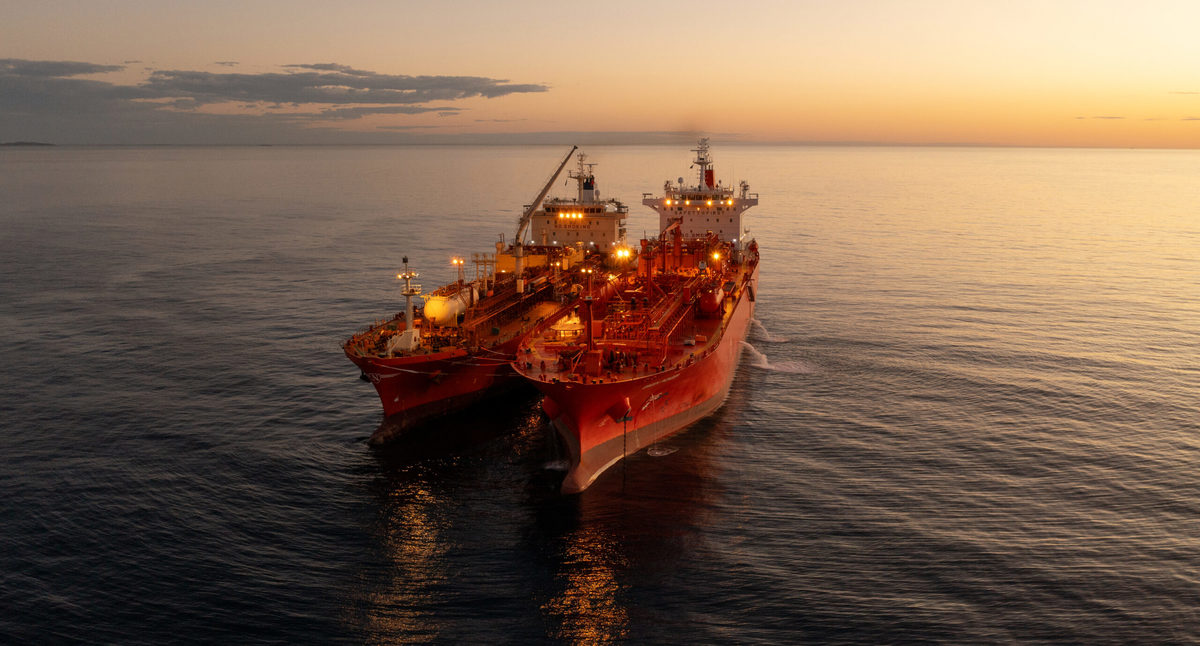Recap 2024: The Year in Alternative Fuels
MEPC 82 discussions stall over policy gridlock
Surging LNG orderbook defied fuel price hikes
Landmark trials explored ammonia as bunker fuel

PHOTO: STS ammonia transfer between Navigator Global and the Green Pioneer at the outer anchorage of Port Dampier. Yara Clean Ammonia
The IMO's Marine Environment Protection Committee (MEPC 82) discussions highlighted ongoing debate over mid-term measures to address shipping emissions, but consensus remained elusive.
Industry stakeholders, including shipping companies, ports, cargo owners, energy suppliers, banks, investors, insurers, class societies, crewing companies and seafarers associations, urged the IMO members to adopt a global fuel standard and a pricing mechanism by 2025.
No agreement on policy options
All policy options are still open for discussions at the IMO. A proposed universal greenhouse gas (GHG) levy received support from 39 countries, with suggested rates ranging from $18.75/mt of CO2-equivalent ($18.75/mtCO2e) to as high as $150/mtCO2e.
15 countries, including some from South America and Southeast Asia, opposed the levy, according to University College London (UCL).
Progress was noted on the greenhouse gas fuel intensity (GFI) standard, with UCL indicating that its text appeared more finalised.
While IMO Secretary-General Arsenio Dominguez reassured industry stakeholders that a pricing mechanism would be in place by 2025, shipping companies noted significant work still needed to be done.
The IMO’s GHG working committee will reconvene at MEPC 83 in March to set regulatory goals, annual targets and the GFI calculation methodology, including whether it will be based on a well-to-wake or adjusted tank-to-wake emission approach.
From oil to gas and back
Fuel switching among dual-fuel vessels was a noticeable trend in 2024, with LNG gaining traction early in the year as its VLSFO-equivalent price in key ports like Singapore and Rotterdam was significantly lower than VLSFO.
By midyear, many dual-fuel vessel owners favoured LNG, but its cost advantage diminished as prices climbed in the second half.
By September, some vessel owners reverted to using oil due to higher LNG delivery premiums, but these premiums declined toward the end of the year. Lower demand may have driven LNG bunker suppliers to reduce delivery premiums.
While LNG prices at key bunker ports rebounded from multi-month lows in the latter half of 2024, shipping giants such as A.P. Moller-Maersk and Hapag-Lloyd went ahead with multi-billion dollar investments in LNG-capable dual-fuel vessel orders. Together, they committed to 44 ships, with deliveries scheduled between 2027-2030.
By the end of 2024, 611 LNG-capable dual-fuel vessels were in operation and another 649 on order for deliveries scheduled towards 2033, according to the DNV database.
Ammonia’s big break
Ammonia has yet to be used as a bunker fuel on ships, but 2024 marked significant progress towards its potential inclusion in the shipping fuel mix. This included a rise in vessel orders designed for ammonia use and tests to assess its operational feasibility.
DNV's database recorded 27 orders for ammonia-capable vessels in 2024.
Australian mining firm Fortescue trialled ammonia as bunker fuel in Singapore, bunkering its Green Pioneer vessel with 4.4 mt and 3 mt of liquid ammonia in separate trials. Diesel was used as a pilot fuel, but the ammonia-to-diesel ratio was not disclosed.
The vessel completed propulsion and manoeuvrability tests, along with safety evaluations of its ammonia storage systems, retrofitted engines and fuel systems.
The same ship was later used by the Global Centre for Maritime Decarbonisation (GCMD) to demonstrate the operational feasibility of ammonia bunkering through a ship-to-ship transfer at Australia’s Port of Dampier.
Approximately 2,700 mt of ammonia was transferred between the Green Pioneer and Navigator Gas’s Navigator Global, highlighting the potential for ammonia bunkering in the Pilbara. Yara Clean Ammonia supplied the ammonia for the operation.
Meanwhile, the IMO approved interim safety guidelines for using ammonia cargo as fuel on ammonia carriers, marking a regulatory breakthrough.
By Konica Bhatt
Please get in touch with comments or additional info to news@engine.online
Here are some stories from the last week of 2024
Recap 2024: LNG and methanol orders surge
ETFuels partners with European duo to build e-methanol plant in the US
BIMCO announces FuelEU Maritime clause for ship management
Auramarine to supply methanol safety systems to two ships
North Ammonia to set up green ammonia production unit in Norway





